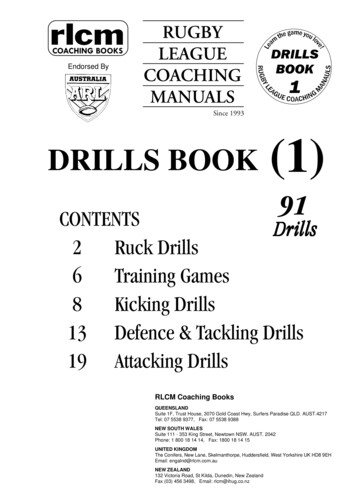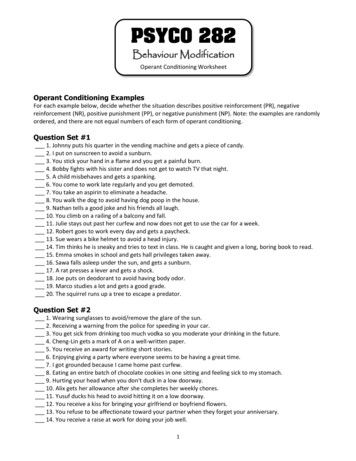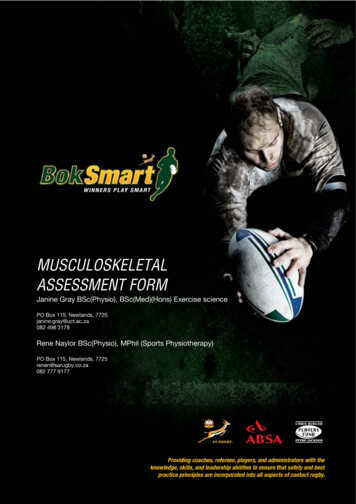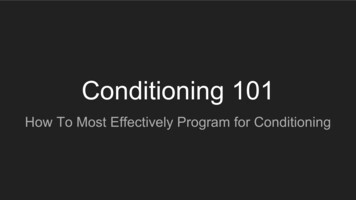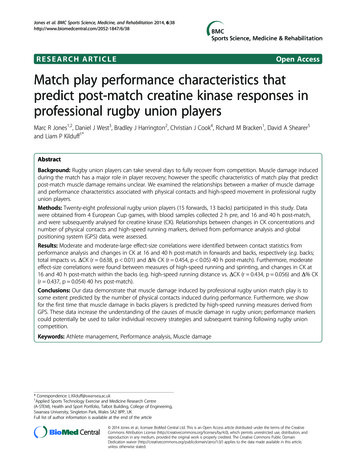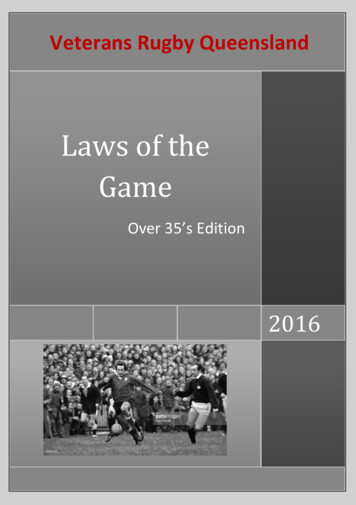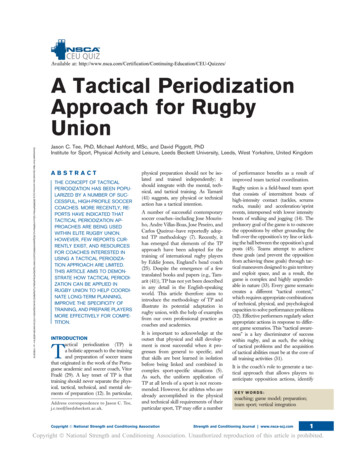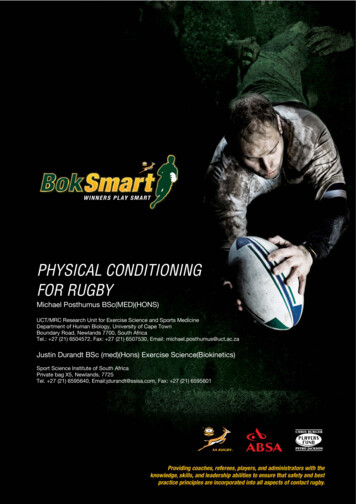
Transcription
Physical conditioning for rugbyPage HeadingMAIN HEADINGSub HeadingsBody CopyBody Copy BoldBody Copy Bold ItalicBody Copy Normal Italic Bullets1. MCL Posterior medial capsulStyle Body for tablesSTYLE HEADING FOR TABLESPHYSICAL CONDITIONINGFOR RUGBYMichael Posthumus BSc(MED)(HONS)UCT/MRC Research Unit for Exercise Science and Sports MedicineDepartment of Human Biology, University of Cape TownBoundary Road, Newlands 7700, South AfricaTel.: 27 (21) 6504572, Fax: 27 (21) 6507530, Email: michael.posthumus@uct.ac.zaJustin Durandt BSc (med)(Hons) Exercise Science(Biokinetics)Sport Science Institute of South AfricaPrivate bag X5, Newlands, 7725Tel. 27 (21) 6595640, Email:jdurandt@ssisa.com, Fax: 27 (21) 65956010Copyright BokSmart 2009
Physical conditioning for rugbyINTRODUCTIONPhysical conditioning for rugby is becoming increasingly important. The modern game is becoming fasterand players are getting bigger(17,21). Conditioning of players not only enables them to play better rugby,but also reduce the risk of injuries(8). Empirical evidence, as well as documented scientific research hasshown that strength, power, speed, agility, fitness and body size are all important attributes for theperformance of a player(7). The physical demands of rugby are complex, and the concurrentimprovements in the above mentioned performance indicators require a carefully planned conditioningprogram(10).Fitness coaches should implement a program of structured variation, referred to as periodisation(18;23). Inaccordance with this the rugby year may be broken down into these specific areas of emphasis. Theresistance training programs typically assign a specific focus to each phase of the training year (Table 1)(3). For example, the off-season phase might focus on general preparation and hypertrophy (an increasein muscle size), where the preseason focuses predominantly on strength and power development.During the season the emphasis should be on the maintenance of levels of conditioning achieved duringthe off- and pre-season periods. Similarly, fitness conditioning emphasis may also be assigned tospecific phases of the training year.Physical conditioning programs designed to increase physical capacities of players are also an effectiveway to reduce injuries(8). In particular, injuries occurring in the contact situation may be decreasedthrough strength training. Therefore, rugby players of all levels should be encouraged to participate inphysical conditioning(2,8). There is a myth that prepubescent and adolescent players should avoidresistance training because it will stunt growth. This myth is not supported by any scientific evidenceand numerous medical, health and professional bodies advocate that there are advantages for youthengaging in resistance training providing the programme is properly designed and supervised with safetechnique and no competition(8). In particular, resistance training has been shown to be the key in theprevention of injury in youth and adolescent athletes. It may therefore be concluded that theimplementation of a properly designed resistance training program will not only give youth and seniorrugby players a competitive advantage throughout their rugby careers, but also reduce the risk ofsustaining an injury.1Copyright BokSmart 2009
Physical conditioning for rugbyOFF-SEASONThe off-season, which is distinguished by not having the constraints of structured team practicesessions, is the most appropriate time for players to emphasise and derive benefit from their resistance(gym) training. The goal of this phase is usually to develop muscle size (hypertrophy), although lessconditioned players should first complete a general preparation period, which increases the body’stolerance to training so that more intense loading may be subsequently endured(3)(10). Larger muscleshave a greater potential to become strong and powerful muscles, which are also factors which determinerugby playing performance(7).Players may be classified, into either beginner, intermediate or advanced depending on how long theyhave performed structured and supervised resistance training (Table 2) (3). Gym training programs shouldbe specifically designed for players of different training experience(2,13). Once beginners have completed8 weeks of gym training they are sufficiently experienced and in a position to progress to an intermediateprogram.Gym training for muscle hypertrophy should include a high volume of training, with generally between 6and 12 repetitions (reps) and a multiple number of sets(2,9,13). The number of reps determine how heavythe weight lifted should be. For example, if 12 reps are prescribed, the player should be able to justcomplete 12 reps with good form and technique. If it is possible to complete more reps, a heavier weightshould be used. This is referred to as a 12 repetition maximum, or 12RM. During the muscle hypertrophyphase of training players with advanced gym training experience may perform up to 6 training sessionsper week(2,13).The amount of fitness conditioning which should be included into this training period is dependent onvarious factors such as body fat levels and current fitness. Specific fitness conditioning prescriptionshould be made for each player depending on their needs and goals. The state of fitness of the player inthe off season is influenced by the length of time since the previous season, as well as duration andactivity during the transition or active rest phase after the previous season. When aerobic fitness is low orwhen body fat levels are high a greater emphasis should be placed on the aerobic fitness conditioning.A trade-off between endurance training and muscle hypertrophy exists(15). Considering that smallerplayers are at a disadvantage against larger more robust players, it makes sense that these playersshould place a greater emphasis on gym training in an attempt to develop muscle size and less onfitness training.2Copyright BokSmart 2009
Physical conditioning for rugbyPRE-SEASONThe beginning of the pre-season, which typically coincides with the start of structured team trainingsessions, should see the introduction of more specific preparation. In the gym there should initially be anemphasis on strength development with a shift towards power development during the second half onthe pre-season(3).Strength, which refers to the maximal force a muscle is able to produce, is a pre-requisite at top levelrugby. To develop strength, one has to lift heavy weights(19,23), but unfortunately one cannot sustain thedemand of lifting heavy weights every workout, and one should thus vary the training stimulus. Lowrepetitions (i.e. 1-6 repetitions), have been shown to be the most appropriate for gains in strength.However, the repetitions which are prescribed are influenced by training experiencehave become sufficiently trained they should keep their repetitions above six(2,13). Until athletes(2,13). Players with weighttraining experience may use heavier loads, closer to their 1RM (the maximum weight they can lift withcorrect form and technique for 1 repetition), but should use a varying range of loads in a periodizedfashion to avoid overtraining(23).Power is the maximal amount of force a muscle can produce over a specific time period(3). By definition itis a product of force (muscle strength) and velocity (speed). For optimal power development players needto focus on both strength and velocity training. Lighter weights should be used during power training asthe emphasis should be on the velocity of the movement and not the size of the weight moved. Olympictype exercises such as the power clean, hang clean, hang-pull etc. are perfectly suited for velocityspecific training. Generally weights of 30-60% of the 1RM should be used for a maximum of 6 reps forpower exercises(2,13). Power exercises should also always be performed first in a non-fatigued state.Heavy strength training, which increases the force component of the power equation should still becontinued in the power phase.As the season approaches, there should also be a shift toward more specific fitness conditioning(10). Thepre-season phase should include aerobic and anaerobic interval type training, and as the start of theseason approaches a greater emphasis should be placed on anaerobic high intensity fitness conditioningwith match specific conditioning drills which mimic the demands of a rugby match. Match specificconditioning drills should attempt to mimic the activities, as well as duration, of periods of work in a rugbymatch. In other words, fitness drills which, for example, include static exertions (e.g. wrestling), leg power(e.g. driving contact shield), maximal intensity sprinting, and agility should be included to get players“match fit”. Agility is also an essential part of rugby specific conditioning. Speed, agility and quickness(SAQ) drills should also be included in the preseason period to enhance performance(6,16). During the preseason period coaches should also adequately prepare players for full contact. Coaches should3Copyright BokSmart 2009
Physical conditioning for rugbygradually progress contact sessions from contact shields and semi-contact drills to full contact drills toavoid unnecessary injury during the pre-season and condition players for match contact.IN-SEASONThe main emphasis and goal of the in-season phase should be to maintain the levels of fitness, strengthand power achieved during the pre-season. This poses a great challenge to fitness trainers, as playersgenerally lose muscle, strength and power as the season progresses due to the increased energydemands of training and competing(1). However, with the implementation of correctly designedconditioning programs throughout the season it is possible to maintain muscle mass, strength andpower. (1,4,5).In accordance with this it is important that players keep on training in the gym throughout the season ontwo separate days of the week(4). The first gym session should be performed early in the week and focuson heavy strength exercises, the second gym session should be performed 48-72 hours after the 1stand should emphasize power development (4). It is important to vary the loads (weight lifted) from week toweek.Fitness conditioning should also be maintained during an in-season period. Coaches often wronglyassume that they do not need to do any fitness conditioning in the in-season period. High intensityinterval type fitness conditioning as well as highly-specific conditioning should be included early in thetraining week to ensure players are fully recovered for their next match. SAQ conditioning should also bemaintained during the season. This type of training is less taxing on the body and may thus beincorporated later in the training week.Although not always possible due to the amount of preparation time required, coaches should attempt tokeep practices as short and sharp as possible. Short sharp sessions will help decrease the physical andpsychological strain associated with long seasons. If possible, players should ideally be monitored andworkloads adjusted according to measures of fatigue(12). It is recommended that players’ training volume,intensity, rate of perceived exertion and mode of training be monitored(24). Monitoring of players,implementation of recovery strategies and ensuring optimal recovery within each week is critical if optimalperformance from week to week is to be ensured(11). Recovery strategies after training and matchesshould include rehydration and refuelling (i.e. ensuring optimal energy levels), a structured cool-downsession, hydrotherapy and relaxation(11).4Copyright BokSmart 2009
Physical conditioning for rugbyTRANSITION/RECOVERY PHASEThe transition phase or active rest phase is critical to ensure adequate recovery after a season hasfinished. Players need to spend 2-4 weeks in this period emphasising recovery, recuperation andrehabilitation(24). It has been widely reported that the greatest risk factor for injury, is a previous injury(14,20).Studies have shown that players who incurred injuries during a season were more likely to develop asubsequent injury in the following season(14,20). possibly because the players were not rehabilitating theirinjuries adequately(14). Therefore it follows that injuries which might have occurred during the season beassessed and musculoskeletal screening be completed by a proficient medical professional during thetransition/recovery phase. The aim of musculoskeletal screening is to assess recovery from any previousinjury and to assess the presence of proven or suspected risk factors for injury in the forthcomingseason. After a full injury history has been taken, a rehabilitation program designed to rectify anyweakness and to restore full function should be prescribed to ensure full recovery before the start of preseason training.Players who are not injured should refrain from any serious training to allow their bodies to recover fully.Only non-sport specific recreational activities performed at low volume and intensity should be performedduring this period(3).AUTHOR’S BIOGRAPHYMichael Posthumus is a PhD student at the UCT/MRC Research Unit for Exercise Science and SportsMedicine, the Department of Human Biology, Faculty of Health Sciences, University of Cape Town,South Africa.Justin Durandt is currently the manager of the Discovery High Performance Centre at the Sport ScienceInstitute of South Africa. Justin has had the privilege of being the conditioning specialist for the nationalcricket, soccer, hockey and Olympic teams. In addition he has trained the WP Currie cup team and theSAU19 rugby team at three world cups5Copyright BokSmart 2009
Physical conditioning for rugbyREFERENCES1. Allerheiligen, B. In-season strength training for power athletes. Strength Cond. Res. 25(3):23 –28. 2003.2. American College of Sports Medicine. Position stand: progressive models in resistance trainingfor healthy adults. Med. Sci. Sports. Exerc. 34:364 – 380. 2002.3. BAECHLE, T.R., R.W. EARLE, D.WATHEN. Resistance training. In: Essentials of strength andconditioning. T.R. BEACHLE, R.W. EARLE ed. Champaign, IL: Human Kinetics, 2000. pp. 395 –425.4. BAKER, D. Applying the in-season periodization of strength and power training to football.Strength Cond. J. 20(2):18 – 24. 1998.5. BAKER, D. The effects of an in-season of concurrent training on the maintenance of maximalstrength and power in professional and college-aged rugby league football players. J. StrengthCond. Res. 15(2):172 – 177. 2001.6. BLOOMFIELD, J., R. POLMAN, P. O’DONOGHUE, L. McNAUGHTON. Effective speed andagility conditioning methodology for random intermittent dynamic type sports. J. Strength Cond.Res. 21(4):1093 – 1100. 2007.7. DUTHIE, G.M., D.B. PYNE, S.L. HOOPER. The applied physiology and game analysis of rugbyunion. Sports Med. 33:973 – 991. 2003.8. FAIGENBAUM, A.D., W.J. KRAEMER, B. CAHILL, J. CHANDLER, J. DZIADOS, L.D. ELFRINK,E. FORMAN, M. GAUDIOSE, L. MICHELI, M. NITKA, S. ROBERTS. Youth resistance training:position statement paper and literature review. Strength Cond. J. 18(6):62 – 76. 1996.9. FLECK, S.J., W.J. KRAEMER. Designing resistance training programs, 2nd edition. Champaign,IL: Human Kinetics, 1987.10. GAMBLE, P. Physical preparation for elite-level rugby union football. National Strength Cond.Assoc. 26(4):10 – 23. 200411. JEFFREYS, I. Post game recovery strategies for rugby. NSCAs Performance training J. 6(4):13 –16. 200712. KELLY V.G., A.J. COUTTS. Planning and monitoring training loads during the competition phasein team sports. 29(4):32 – 37. 2007.13. Kraemer W.J., N.A. ratamess. Fundamentals of resistance training: progression and exerciseprescription. Med. Sci. Sports. Exerc. 36(4):674 – 688. 2004.14. LEE A.J., W.M. GARRAWAY, D.W. ARNEIL. Influence of preseason training, fitness, and existinginjury on subsequent rugby injury. Br. J. Sports Med. 35:412 – 417. 2001.15. LEVERITT, M., P.J. ABERNETHY. Acute effects of high-intensity endurance exercise onsubsequent resistance activity. J. Strength Cond. Res. 13(1):47 – 51. 1999.6Copyright BokSmart 2009
Physical conditioning for rugby16. ne2.2008.17. OLDS, T. The evolution of physique in male rugby union players in the twentieth century. J.Sport. Sci. 19:253 – 262. 2001.18. Pearson, D., A. Faigenbaum, M. Conley, W.J. Kraemer. The National Strength and ConditioningAssociation’s basic guidelines for the resistance training of athletes. National Strength Cond.Assoc. 22(4):14 - 27. 2000.19. PETERSON, M.D., M.R. RHEA, B.A. ALVAR. Maximising strength development in athletes: ameta-analysis to determine the dose-response relationship. J. Strength Cond. Res. 18(2):377 –382. 2004.20. QUARRIE, K.L., J.C. ALSOP, A.E. WALLER, Y.N. BIRD, S.W. MARSHALL, D.J. CHALMERS.The New Zealand ,rugby injury and performance project. VI. A prospective cohort study of riskfactors for injury in rugby union football. Br. J. Sports Med. 35:157 – 166. 2001.21. QUARRIE, K.L., W.G. HOPKINS. Changes in player characteristics and match activities in theBledisloe cup rugby union from 1972 to 2004. J. Sports Sci. 25(8):895 – 903. 2007.22. RHEA, M.R. B. A. ALVAR, L.N. BURKETT, S.D. BALL. A Meta-analysis to determine the doseresponse for strength development. Med. Sci. Sports. Exerc. 35(3):456 – 464. 2003.23. RHEA, M.R., B.L. ALDERMAN. A meta-analysis of periodized versus non periodized strengthand power training programs. Res. Q. Exerc. Sport. 75(4):413-22. 2004.24. South African Rugby Union (SARU). Medical committee report: The first South African medicaland scientific consensus conference: Cape Town. 8-9th November 2005.7Copyright BokSmart 2009
Physical conditioning for rugbyTABLE 1: DIVISION OF THE RUGBY YEAR INTO ITS RESPECTIVE easonPhaseStrengthPowerAerobicAnaerobic& anaerobic& aseStrength and Power MaintenanceRestFitness MaintenanceRestT Transition period; R Rest; GP GP General preparation*This phase is dependent on current state of conditioning, it might not be necessary in advancedindividuals.During the off-season and pre-season phases the emphasis between aerobic and anaerobic fitnessconditioning is depicted by font size.TABLE 2: CLASSIFICATION OF PLAYERS ACCORDING GYM TRAINING EXPERIENCETraining StatusTraining AgeBeginner 8 weeksIntermediate 8 weeks, and 12monthsAdvanced 12monthsTraining age Duration that a structured resistance training program has been followed.SENIOR CONDITIONING PROGRAMSThe Periods of the rugby training year:8Copyright BokSmart 2009OCT
Physical conditioning for rugbyThe Conditioning programs are divided into 4 periods as defined below;1. Off-season; Defined as the period after the transition phase of the previous season and the preseason structured team practice. In the programs outlined below 12 weeks of training have beenassigned to this period.2. Pre-season; Defined as the period between the first pre-season structured team practice andthe first league match. The pre-season period may be divided into 2 phases, which may beseparated by the first friendly or practice match. In the programs outlined below the 12 weekpre-season period has been broken down into two 6 week phases. The first 6 week phaseshould emphasise strength and the next 6 week phase should emphasise power development.3. In-season; Defined as the duration of the season, i.e. the period between the first and last leaguematch.4. Transition period/active rest period; Defined as the 2-4 weeks after the in-season period. Noconditioning programs have been prescribed for this period, as players should give their bodiesa break during this period.Players may stay active by participating in non sport-specificrecreational activities performed at low volume and intensity, but no structured training isnecessary. Where necessary, players should follow a rehabilitation program, to ensure recoveryof injury between seasons.Resistance training guidelines:Resistance training sessions are prescribed for the length of the off-, pre- and in-season periods. Eachspecific workout is defined in the SPECIFIC WORKOUT AND CONDITIONING PROGRAMS section,and each exercise mentioned is described within the EXERCISE DESCRIPTION section.Resistance training status (Beginner, Intermediate, Advanced):Before the resistance training programs are assigned, players should be classified into either beginner,intermediate or advanced according to their resistance training experience (see Table 2). Once beginnershave completed the 8 week preparatory period (i.e. 8 weeks of the beginner programs outlined for theoff-season period), they may advance onto the intermediate program. A beginner starting resistancetraining in the pre- or in-season should always perform the first 8 weeks of the off-season period beforestarting the intermediate program. If this beginner off-season program is followed in the in-seasonplayers may eliminate the circuit and fitness conditioning.No gym access alternatives:Within each workout there are options for individuals without access to gym equipment;9Copyright BokSmart 2009
Physical conditioning for rugby1. No gym alternative workout; These workouts rely on resistance applied from a team-mate ortraining partner. This alternative is given within all beginner and intermediate programs. Due tothe greater difficulty with variation of load, players should rather perform as many repetitions(reps) as possible, and only use the prescribed rep range when variable resistance is possible.Due to the difficulty applying variable resistance and the limited exercise selection no gymalternatives are given for the advanced section.2. No training partner alternative; When there is no team mate or training partner available to trainwith players should perform this alternative. Players only require resistive tubing (i.e. bicycle tyretube, theraband, toning tube etc.). Due to the greater difficulty with variation of load, playersshould rather perform as many reps as possible and only use the prescribed rep range whenvariable resistance is possible. Due to the difficulty applying variable resistance and the limitedexercise selection only “no training partner alternatives” are given for the beginner program in theoff-season phase. Players without gym access and without a training partner or team mateshould thus remain performing these workouts.Load (weight) selection:The number of reps determines how heavy the weight lifted should be, i.e. if 12 reps are prescribed, aweight should be selected for which 12 reps may be performed with good form and technique. If it ispossible to complete more reps a heavier weight should be used. A repetition maximum is the maximumamount of repetitions which can be performed with a certain weight. Weights should be selectedaccording to the RM prescription.10Copyright BokSmart 2009
Physical conditioning for rugbyGeneral precautions:1. When starting an exercise ensure one is sufficiently warm, complete a warm up set of 10 repswith the weight being 50% of the weight normally used. This warm-up set does not count as aworking set.2. Always ensure the correct breathing patterns are used. Always take a deep breath (inhale) whilethe specific muscle worked is being lengthened (eccentric muscle action), and breath out(exhale) while the weight is being pushed or pulled. Do not hold your breath while performing anyexercise.3. Never work with symptoms of pain; if a certain exercise cause’s pain, the player shouldimmediately decrease the amount of weight. If this is not successful, then leave out that specificexercise for one week. If the pain is still present after one week when retrying the exercise, thenleave that specific exercise out of your routine and consult a proficient medical professional.4. Always perform a 10 minute warm-up, followed by 5 minutes of stretching prior to a trainingsession. Prior to an exercise session players should use dynamic stretches (joint movementswhere the range is gradually increased). After every session players should stretch, using staticstretches (where a stretch is held for 20-30 seconds) for 5 minutes. Never stretch to the point ofcausing pain, one should only feel a pulling sensation.5. Always use good form and technique as described in the EXERCISE DESCRIPTION section.6. Always use a spotter when performing heavy lifts.7. When picking up a weight off the floor, always bend your knees and keep your back straight.Fitness conditioning guidelines:Fitness conditioning during the off-season period is prescribed for players to follow by themselves toprepare themselves for the pre-season period. Depending on individual needs, players may choose to doless or more. Players needing to gain weight should cut one fitness conditioning session a week andplayers wanting to lose weight should perform an extra fitness conditioning session.Fitness conditioning drills 1 to 4 (FC1, FC2, FC3, FC4) are prescribed for the off-season phase. There is aprogressive shift from FC1 to FC4, FC1 is a low intensity aerobic workout, whereas FC4 is a very highintensity, predominantly anaerobic workout. Players needing to gain muscle mass should rather performshort duration high intensity anaerobic workouts, i.e. FC4, during the off-season period.During the pre- and in-season, fitness conditioning is prescribed within the structured team practice(PRAC) sessions. Examples of team structured training sessions (PRAC) are provided for the 2 phases of11Copyright BokSmart 2009
Physical conditioning for rugbythe pre-season, as well as the in-season period. These PRAC sessions may be used as an example toguide coaches, but may be altered depending on the needs of the team.Each specific conditioning session is defined in the SPECIFIC WORKOUT AND CONDITIONINGPROGRAMS section. Within the team PRAC sessions SAQ drills are prescribed, please see theEXERCISE DESCRIPTION section for examples of SAQ drills coaches might choose to use during thistime.Disclaimer:Although all the exercises are clearly described, and photo’s of correct technique are attached, playersshould consult with a suitable qualified person (e.g. a biokineticist) to ensure proper technique is used inall the programs. BokSmart may not be held liable for any injury or harm incurred as a result of using thisconditioning program.12Copyright BokSmart 2009
Physical conditioning for rugby5--12Week 5FC1IWTC1LBEFC2IWTC2RESTRepeat BEGINNER CYCLE1 for 8 BELBEIWTC1FC1Once 8 weeks has beenperformed a player mayadvance to INTERMEDIATECYCLE 2 program for theremaining weeks of the offseason period.IH1IH2FC1 or FC2IH3IH1FC3/GFD1*IH2IH3FC1 or FC2IH1IH2FC4/GRM2*IH3ADVANCED CYCLE 1PMINTERMEDIATE CYCLE 1BEGINNERCYCLE yBeginnerAMUBEINTERMEDIATE CYCLE 2Week 4Week 3Week 2Week 1OFF-SEASON CONDITIONING PROGRAM (WEEK H3FC3/GFD1*AH1AH2FC4/GFD2*PMAH3Repeat ADVANCED CYCLE 1 forthe duration of the off-seasonperiod.Repeat INTERMEDIATE CYCLE 2for the duration of the off-seasonperiodWeek13: Rest 1 week before progressing to Strength Phase (Pre-season period)UBE UpperBody EnduranceUBELBE LowerLBEBody EnduranceIWTC1 or IWTC2IWTC 2 Interval Weight Training Circuit 1 or 2IH1, IH2 or IH3 IH3 Intermediate Hypertrophy Program 1, 2 or 313Copyright BokSmart 2009
Physical conditioning for rugbyAH1, AH2 or AH3 AH3 Advanced Hypertrophy program 1, 2 or 3FC1, FC2, FC3 or FC4 FC4 Fitness Conditioning 1, 2, 3 or 4.* You may choose to rather perform an on-field session GFD1 or GFD2 instead of FC3 and FC4respectively, similar work:rest ratios should be used as described in FC3 and FC4.Please see the SPECIFIC WORKOUT AND CONDITIONING PROGRAMS section for further detailsand outline of each session above.Each exercise within the programs is detailed in the EXERCISE DESCRIPTION section.PLEASE SEE DISCLAIMER BEFORE STARTING THE CONDITIONING PROGRAM.4--6Week 4Week 3Intermediate CPRACIS3IS4PRACRESTRESTRESTRepeat INT STRENGTH CYCLEfor the duration of the strengthphase (i.e. the cycle getscompleted 3 times)ADV STRENGTH undayINT STRENGTH CYCLEWeek 2Week 1PRE-SEASON CONDITIONING PROGRAM - PHASE 1 (STRENGTH) (WEEK 1-6):Advanced TRESTRepeat ADV STRENGTHCYCLE for the duration of thestrength cycle (i.e. the cycle getscompleted 2 times)Week 7: Rest 1 week before advancing to the Power Phase14Copyright BokSmart 2009
Physical conditioning for rugbyIS1, IS2, IS3 or IS4 IS4 Intermediate Strength Program 1, 2, 3 or 4AS1, AS2, AS3 or AS4 AS4 Advanced Strength Program 1, 2, 3 or 4PRAC PRAC Team Practice session.An example of a team PRAC specific to this period is described belowPlease see the SPECIFIC WORKOUT AND CONDITIONING PROGRAMS section for further detailsand outline of each session above.Each exercise within the programs is detailed in the EXERCISE DESCRIPTION section.PLEASE SEE DISCLAIMERDI SCLAIMER BEFORE STARTING THE CONDITIONING PROGRAM.TEAM PRACTICE (PRAC) SESSION EXAMPLE OUTLINE - PRE-SEASON (WEEK 1-6) (EXAMPLE):Monday17h30 - 18h0018h00 - 18h3018h30 - 18h3518h35 - 18h5518h55 - 19h0
have performed structured and supervised resistance training (Table 2) (3). Gym training programs should be specifically designed for players of different training experience (2,13). Once beginners have completed 8 weeks of gym training they are sufficiently experienced
